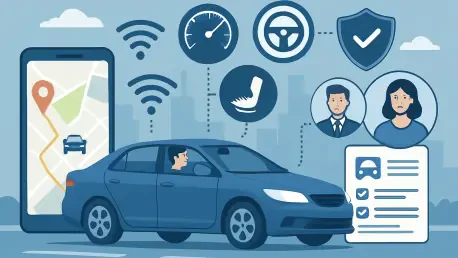Picture this: a cautious driver who rarely speeds, always signals, and avoids rush-hour chaos pays the same steep insurance premium as a reckless speedster who weaves through traffic daily. This glaring inequity, long accepted as the norm in auto insurance, is finally being disrupted. A quiet revolution powered by technology is reshaping how premiums are calculated, shifting the focus from broad assumptions to the nitty-gritty of individual driving habits. This seismic change promises a fairer system, but it also raises questions about privacy and trust that demand attention.
Why Driving Habits Trump Demographics
Traditional insurance models have relied heavily on factors like age, location, and gender to estimate risk, often painting drivers with a broad brush that ignores their actual behavior on the road. A 25-year-old urban dweller might face sky-high rates simply due to statistics, even if their driving record is spotless. Such generalizations have frustrated countless policyholders who feel penalized for factors beyond their control.
Telematics, a cutting-edge fusion of telecommunications and data tracking, flips this outdated script. By monitoring real-time driving patterns—think braking sharpness, acceleration habits, and even the time of day a car is on the road—this technology crafts a risk profile as unique as a fingerprint. Insurers can now see who truly deserves a break on rates and who might need a nudge to drive more safely.
The implications are profound. No longer are premiums a one-size-fits-all gamble; they become a reflection of personal responsibility. This shift not only feels fairer but also incentivizes safer roads, as drivers realize their actions directly impact their wallet. The question remains, though, how does this tech actually work in practice?
Decoding the Tech: Telematics and Usage-Based Insurance
At its core, telematics combines GPS, onboard vehicle diagnostics, and sometimes smartphone apps to gather a treasure trove of data from a car. This isn’t just about tracking a vehicle’s location; it’s about capturing specifics like how quickly a driver stops at a red light or whether they tend to speed on highways. These metrics paint a vivid picture of risk that static demographic data could never match.
Usage-based insurance (UBI) is the practical outcome of this innovation, allowing insurers to tie premiums directly to driving behavior. A study by the Insurance Research Council found that over 20% of U.S. drivers are now enrolled in UBI programs, a number steadily climbing since 2025. This trend reflects a growing demand for transparency, especially among younger drivers tired of being lumped into high-risk categories based on age alone.
Beyond fairness, telematics addresses pressing societal needs. With road safety concerns mounting—over 40,000 fatal crashes occur annually in the U.S.—this technology offers tools to encourage better habits. Insurers provide feedback through apps, showing drivers where they can improve, while the financial carrot of lower rates keeps motivation high. It’s a win-win that’s hard to ignore.
Personalization in Action: From Broad Strokes to Fine Details
The magic of telematics lies in its granular approach. Unlike old-school models that guessed risk based on zip codes or marital status, this tech collects hard data on mileage, speed patterns, and even how smoothly a driver handles turns. Each data point feeds into a tailored risk assessment, ensuring that a grandmother who drives 10 miles a week isn’t charged the same as a daily commuter racking up hundreds.
For everyday drivers, the benefits are tangible. Safe habits can slash premiums by up to 30%, according to reports from major insurers like Progressive and Allstate. Many UBI programs also offer real-time feedback, gamifying the driving experience with scores and tips to refine skills. Imagine getting a notification after a trip suggesting gentler braking for a better rate—small changes add up fast.
Commercial fleets are reaping rewards too. Businesses using telematics save millions annually through optimized routes and reduced fuel waste, as noted in a 2025 industry survey showing 40% of large fleets adopting the tech. Whether it’s a solo driver or a logistics giant, the shift to personalized policies is proving that data-driven precision beats outdated assumptions every time.
Voices from the Trenches: Experts and Drivers Weigh In
Industry insiders see telematics as a game-changer for equity in insurance. “This technology levels the playing field by focusing on behavior over bias,” says Sarah Bennett, a senior analyst at the National Insurance Institute. Her perspective aligns with studies showing that 60% of UBI participants improve their driving within six months, motivated by both savings and safety insights.
On the ground, drivers echo this enthusiasm. Take Mark Thompson, a 38-year-old father from Ohio, who cut his premium by 25% after joining a telematics program. “Seeing my driving score after each trip made me slow down on sharp turns,” he shared. “It’s like having a coach in the car, and the lower bill doesn’t hurt either.” His story highlights the human impact of this tech, turning abstract data into real-world gains.
These voices, paired with hard numbers, build a compelling case. A 2025 report from the Insurance Information Institute revealed that UBI adoption has grown by 15% annually, driven by consumer trust in personalized pricing. From analysts to everyday motorists, the consensus is clear: telematics isn’t just a trend—it’s a fundamental rethink of how risk should be measured.
Tackling the Hurdles: Privacy and Practical Fixes
Despite the promise, telematics isn’t without roadblocks, chief among them being privacy concerns. The idea of an insurer knowing every turn, stop, and late-night drive can feel intrusive. Many drivers worry about data misuse or sharing with third parties, a valid concern given the sensitivity of location-based information.
Insurers are stepping up to address these fears with concrete measures. Opt-in programs ensure consent is explicit, while data anonymization strips personal identifiers from records. Transparency policies, now standard among top providers, detail exactly what’s tracked and how it’s used. Drivers are encouraged to research these safeguards before signing up, prioritizing companies with strong privacy commitments.
Empowerment is key to navigating this landscape. Staying informed about state and federal regulations, which are evolving to protect consumer data, helps maintain control. For those on the fence, starting with short-term UBI trials offers a low-risk way to test the waters. Balancing the perks of tailored rates with personal boundaries is entirely possible with the right approach.
Looking back, the journey of telematics in auto insurance stands as a bold leap toward fairness and accountability. It redefined how risk was assessed, rewarding careful drivers while nudging others to improve. The path wasn’t without bumps—privacy debates sparked heated discussions, and regulatory gaps demanded attention. Yet, the progress made set a powerful precedent. Moving forward, stakeholders must prioritize robust data protection laws to sustain trust. Drivers, meanwhile, can take charge by exploring UBI options with clear policies, ensuring they reap the benefits without compromise. The road ahead hinges on collaboration, promising a system where technology and ethics drive side by side.









